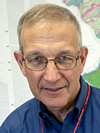
Ken Miller
Rutgers University
2018 Laurence L. Sloss Award
Presented to Ken Miller
Citation by David Hodgson and Peter Sugarman
Professor Ken Miller has been a pioneer and global leader in the interpretation of the stratigraphic record as an archive of coastline responses to sea level change, and has highlighted the socio-economic consequences of accelerated sea level rise. His agenda-setting publications, whether questioning an ice-free South Pole during the Cretaceous, or establishing and refining the global eustatic sea-level curve for the Cenozoic, have challenged orthodoxies and shaped our science. Of particular relevance for the Lawrence L. Sloss Award is Ken’s ability to integrate different stratigraphic datasets and tools, be it chronostratigraphy, biostratigraphy, sedimentology, and seismic sequence stratigraphy. Arguably, his greatest achievement has been in establishing the New Jersey Margin as the global laboratory in the study of Cenozoic sea-level change, and has lead multiple internationally collaborative onshore and offshore drilling campaigns.
Throughout his career Ken’s passion and commitment to his subject has inspired countless students, colleagues and collaborators. His collaborative and integrative approach is the foundation for significant scientific advances in our understanding of global controls on the stratigraphic record that he and his team have made over the last three decades. The entertaining, yet data-rich, delivery of his presentations are legendary.
He is a long-term supporter of the community, convening numerous sessions at GSA and AGU meetings, has been an associate editor of several SEPM and GSA publications, and has been a long advocate for the IODP. From personal experience, it was a thrill working with Ken, with his impressive ability to consume, digest, and synthesise data. Refreshingly, he is not wedded to his own models and interpretations – for Ken, the data will out.
In summary, Ken is a force of nature. He has challenged and driven forward the research landscape of stratigraphy. I cannot think of a more worthy, distinguished, and active awardee of the Lawrence L. Sloss Award.
 2018 Laurence L. Sloss Award — Response by Ken Miller
2018 Laurence L. Sloss Award — Response by Ken Miller
I had the great pleasure of meeting Larry Sloss in the early 1980’s while a graduate student, when he graciously welcomed me to a GSA national meeting. I was well aware of Larry’s work on sequences from my interactions with his former student Peter Vail. At my first poster session as a grad student in 1979, Dick Olsson and I were surrounded by Vail and Exxon colleagues, where I tried to defend our ideas of Oligocene sea level and glaciation. Pete built his work on the foundation established by Sloss. Both were major proponents of the idea that unconformities (sequence boundaries) are the fundamental building blocks of the stratigraphic record. Pete further recognized that seismic reflections image unconformities, cutting time-transgressive lithologies. Though Larry favored tectonics as the primary control of his supersequences (which spanning 30 to over 100 Myr), Pete was an advocate that global sea-level changes control Myr sequences. I still am working to discern the influences on sea level records of not just the Oligocene, but also from the Jurassic to the future, as human CO2 emissions contribute to the melting the great ice sheets.
I have spent the past 25 years drilling to determine the ages and paleoenvironments needed to reconstruct sea-level variations, using New Jersey (NJ) as a natural laboratory. After 20 years of planning, in 2009 IODP Exp 313 drilled on the NJ shelf, allowing us to objectively recognize sequence boundaries by reflector terminations, sharp changes in stacking patterns, and bio- and chemostatigraphically constrained hiatuses. In our most recent paper, we advocated for a return to “back to basics of sequence stratigraphy,” eschewing implicit ties of sequences to sea level. Larry Sloss also did this: he empirically noted –sequences on the craton and then correlated them from continent to continent. Only then, did he venture into the causal mechanism. Was it climate or tectonics that cause these changes? The answer is “yes”.
We can begin to answer the questions of causal mechanisms by integrating techniques from stratigraphy, geophysics, and geochemistry. We have applied independent proxies of d18O and Mg/Ca to evaluate ice sheet and sea level changes. We have shown that at ~34 Ma we entered a largely unipolar icehouse that paced global mean sea level changes of 10-60 of m, and that ~2.7 Ma we entered a bipolar icehouse with larger (~60-120 m) changes. Sequence stratigraphy points at smaller, but apparently global sea-level changes in the Hothouse and cool Greenhouses of the Jurassic to Eocene. Were Greenhouse sequences paced by ice, tectonics, or other processes? As of now, we can only say yes. I think Larry would smile at that answer.
I thank my wife and children, Rutgers EPS, and the IODP for support and the Sedimentary Geology Division and my nominators Dave Hodgson and Pete Sugarman for this honor. Stratigraphy, as pioneered by Sloss, is an interdisciplinary field. My career in stratigraphy has benefited by close interactions with sedimentologists, geophysicists, and geochemists. I have many to thank for these collaborations that hopefully have advanced the field of stratigraphy.
